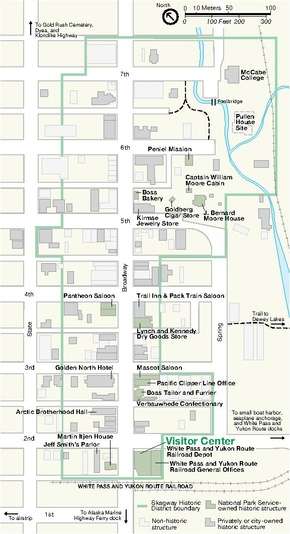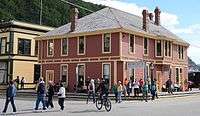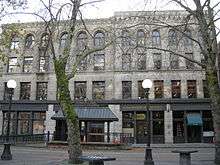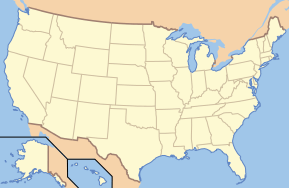Klondike Gold Rush National Historical Park
| Klondike Gold Rush National Historical Park | |
|---|---|
|
IUCN category V (protected landscape/seascape) | |
|
White Pass & Yukon Route Railway Administration Building serves as a museum | |
 | |
| Location | Alaska and Washington, United States |
| Nearest city | Skagway, Alaska and Seattle, Washington |
| Coordinates | 59°27′23″N 135°18′43″W / 59.45639°N 135.31194°WCoordinates: 59°27′23″N 135°18′43″W / 59.45639°N 135.31194°W |
| Area | 12,996 acres (5,259 ha)[1] |
| Established | June 30, 1976 |
| Visitors | 860,048 (in 2011)[2] |
| Governing body | National Park Service |
| Website | Klondike Gold Rush National Historical Park |
Klondike Gold Rush National Historical Park is a national historical park operated by the National Park Service that seeks to commemorate the Klondike Gold Rush of the late 1890s. Though the gold fields that were the ultimate goal of the stampeders lay in the Yukon Territory, the park comprises staging areas for the trek there and the routes leading in its direction. There are four units, including three in Municipality of Skagway Borough, Alaska and a fourth in the Pioneer Square National Historic District in Seattle, Washington.
A fuller appreciation of the story of the Klondike Gold Rush requires exploration and discovery on both sides of the Canada–United States border. National historic sites in Whitehorse and Dawson City, Yukon, as well as in British Columbia, complete the story. In 1998, Klondike Gold Rush National Historical Park joined with Chilkoot Trail National Historic Site, Dawson Historical Complex National Historic Site, and "The Thirty Mile" stretch of the Yukon River to create Klondike Gold Rush International Historical Park, allowing for an integrated binational experience.
Historic Skagway




The Skagway unit includes much of the historic downtown such as buildings owned and restored by NPS and others, some leased even today for ordinary commercial purposes to recreate the city's bustling activity. The visitor center in Skagway is located in railroad depot building at Second and Broadway and is a good place to begin tours either led by a ranger or self-guided. Junior rangers can plan their activities further and earn their badges further up Broadway at the Pantheon Saloon.
- White Pass & Yukon Route Railway Broadway Depot. Second & Broadway. Now serving as the park's Visitors Center and Headquarters, the depot was the first building the railway built for this purpose, completed in December 1898. The structure served this purpose at least until the 1950s. However, together with the adjoining administration building and the railway itself, these were taken over by the U.S. Army Railway Operating Battalion from 1942 to 1946 to supply construction of the Alaska Highway, the first land route to Alaska, then under construction in adjoining British Columbia and Yukon Territory as part of the war effort. It was the only commercial railway in the United States taken over for this purpose. The building was transferred to NPS in 1976 with restoration completed in 1984, returning its appearance to the 1908-1915 time period.[3]
- White Pass & Yukon Route Railway Administration Building. Second east of Broadway. The bottom floor houses the park museum while additional park offices are located upstairs. Located next to the depot, the Daily Alaskan noted during the year of its completion in its May 3, 1900 edition that it the railway's headquarters was "by far the finest wooden structure in the city". As with the depot, it was vacated in 1969, transferred to NPS in 1976, with restoration completed in 1984.[4]
- Martin Itjen's House. Broadway between First and Second. The building serves as the NPS and Parks Canada Trail Center, and is one of the first structures visitors to the park arriving by ship see. Originally it stood on piers by the wharf, completed in 1902, and is reminiscent of homes built for railway employees. In 1922, it was sold to Martin Itjen who had learned to profit from the summer tourist trade by greeting passers-by and selling tours of the town's attractions. Relocation of railway tracks in 1946 isolated the house, which after two intermediate moves ended up on Sixth. NPS acquired the structure in 1978, moving it to its current position 300 feet (92 m) west of its original location. Restoration was completed in 1991 to return the home to the 1921-1941 period.[5]
- Jeff. Smith's Parlor. Second west of Broadway. The building was most famously used as a base of operations by con man and outlaw Jefferson "Soapy" Smith who ended up in Alaska by way of Denver. He and his gang defrauded and tricked miners for only three months before Smith was shot to death in spectacular fashion on the Skagway wharf. Martin Itjen bought the saloon in 1922, and outfitted it as a museum with animatronic figures of Soapy Smith and his associates. Even after selling it in 1950, the museum remained in operation until 1986. Donated to NPS in 2007, the building was refurbished to its old glory as it would have been seen by visitors back in 1967, and reopened in April 2016.[6]
- Verbauwhede's Cigar Store, Confectionery, and Cribs. Broadway between Second and Third. Frederick Verbauwhede originally opened a store selling cigars and confections here in 1898, and in 1902 moved one-story "cribs" behind the store from their previous location between Fourth and Fifth where they housed prostitutes. A gunsmith, jeweler, gas station and travel agency occupied the premises at one time or another through 1977 when NPS purchased the buildings. Restored in 1986, the cigar store is leased to a private business while the cribs are used by the park's law enforcement operations.[7]
- Boas Tailor & Furrier Shop. Broadway between Second and Third. As the name implies, it was formerly, though briefly, a furrier, topped by a traditional high wooden false front as seen in other western towns in the United States and Canada. After a series of other business, it was sold to NPS in 1978 with period restoration completed in 1986. It is now leased to private business to encourage a feeling of Skagway as a center of bustling business activity.[8]
- Pacific Clipper Line Office. Broadway near Third. First serving the considerable steamship trade that brought passengers to Skagway that lack other means of access, the building later became a liquor store before Skagway was hit by municipal prohibition in 1916 and other uses were found for it. NPS acquired the building in 1976, and after restoration began leasing it to private business in 1990.[9]
- Mascot Saloon. Broadway and Third. The saloon opened in 1898 and unlike few others survived as bar through prohibition in Skagway in 1916. After that it was used as a drugstore and for other purposes until it was transferred to NPS in 1976. It was restored to its post-rush period appearance and reopened as an exhibit in 1990.[10]
- Lynch and Kennedy Dry Goods Store. Broadway between Third and Fourth. Originally built in 1900 as barracks for the all-black Company L 24th Infantry. The building was moved from Sixth to Broadway and a false front was added in order to open a haberdashery and dry goods store in the location in September 1908. The Daily Alaskan described the store as "just about the most handsomest in the city". All the same it closed by 1920, and thereafter served variously as a restaurant and again as barracks before being purchased by NPS in 1977. Restoration was completed in 1990, returning it to the 1908-1915 time period. It is leased to a private business.[11]
- Pantheon Saloon. Broadway and Fourth. Though a hardware store in 1898, the Pantheon became a saloon in 1903 and stayed in business until municipal prohibition in 1916. It served varied functions before being sold to NPS in 1977. Now restored to its 1903-1916 appearance, the Pantheon invites in young visitors to explore the park and earn their Junior Ranger patches.[12]
- Moore Homestead. The first homestead in Skagway, which predates the gold rush era.[13]
- Peniel Mission. Originally a Christian mission, now used as modest housing for the park's seasonal employees.[14]
White Pass Trail
The park includes as one of its units the White Pass Trail. White Pass is a mountain pass that leads from Skagway to the headwaters of the Yukon River in British Columbia. The trail was one of the two main routes used by prospectors to get from Skagway over the Boundary Range on their way to the gold fields in the Yukon. The White Pass and Yukon Route railway, completed in 1900, used White Pass to bring prospectors from Skagway to Whitehorse, Yukon.
Dyea Townsite and Chilkoot Trail
The historic townsite of Dyea is also part of the historical park, from which the Chilkoot Trai leaves and runs to Bennett Lake in British Columbia. From there, prospectors generally rafted to Dawson City, Yukon. The trail center in Skagway, operated by both the National Park Service and Parks Canada, has information regarding current conditions along the Chilkoot Trail as it travels through both countries. A permit is required to hike the 33-mile (53-kilometer) trail.
Seattle unit


An integral part of the park is the Visitor's Center in Seattle, Washington, in the Pioneer Square National Historic District. It functions as an interpretive center and museum, and also has information on how to visit the Skagway units of the park. It opened June 2, 1979,[15] and was originally located in the Union Trust Annex (built 1902),[16] across Main Street from Occidental Park.[17]
The Seattle unit is now located in an 1889 building, the Cadillac Hotel at 319 Second Avenue South. The Cadillac Hotel building was a major point of outfitting and departure during the gold rush stampede. Severely damaged in the 2001 Nisqually earthquake, it was rehabilitated 2004–2005 as home to the Seattle unit of the park, and was opened and dedicated on June 26, 2006.[18][19] The National Park Travelers Club held its 2014 convention at Klondike Gold Rush.[20]
International Park

In 1969, the United States and Canadian governments jointly declared their intention to make Chilkoot Trail a component of a Klondike Gold Rush International Historic Park. The U.S. portion was eventually established in 1976 as part of Klondike Gold Rush National Historical Park.
The Canadian portion of the trail became Chilkoot Trail National Historic Site, one of several sites in the national park system associated with the Klondike. But it was not until the centennial of the gold rush, in 1998, that the dream of an international park was realized, when Klondike Gold Rush National Historical Park and Chilkoot Trail National Historic Site were declared to constitute jointly the Klondike Gold Rush International Historical Park.[21] Their previous legal names were retained, while the new name reflected co-operative management between the two park services, and the formalization of relations which had in fact been going on for years.
Beyond this, joint resolutions recognize the relevance to gold rush interpretation of the Dawson Historical Complex National Historic Site, in Dawson City, Yukon, which includes significant buildings. Parks Canada identifies Dawson City as a unit of the international park,[22] as well as "The Thirty Mile" section of the Yukon River, a national heritage river from Lake Laberge to the Teslin River. The river has been recognized by both countries as part of their joint interpretative efforts.[23]
Beyond the formal international historical park are national historic sites in Yukon concerned with the gold rush:
- Discovery Claim National Historic Site NHS
- SS Keno NHS
- Dredge No. 4 NHS
- SS Klondike NHS
- Yukon Hotel NHS
- Canadian Bank of Commerce NHS
- Former Territorial Court House NHS
- Old Territorial Administration Building NHS
References
- ↑ "Listing of acreage as of December 31, 2011". Land Resource Division, National Park Service. Retrieved 2012-03-19.
- ↑ "NPS Annual Recreation Visits Report". National Park Service. Retrieved 2012-12-14.
- ↑ "White Pass & Yukon Route Railway Broadway Depot". NPS. Retrieved 16 May 2016.
- ↑ "White Pass & Yukon Route Administration Building". NPS. Retrieved 16 May 2016.
- ↑ "Martin Itjen's House". NPS. Retrieved 16 May 2016.
- ↑ "Jeff. Smith's Parlor Museum". NPS. Retrieved 16 May 2016.
- ↑ "Verbauwhede's Cigars, Confections and Cribs". NPS. Retrieved 16 May 2016.
- ↑ "Boas Tailor & Furrier Shop". NPS. Retrieved 17 May 2016.
- ↑ "Pacific Clipper Line Office and Hern Liquor Store". NPS. Retrieved 17 May 2016.
- ↑ "Mascot Saloon". NPS. Retrieved 17 May 2016.
- ↑ "Lynch and Kennedy". NPS. Retrieved 17 May 2016.
- ↑ "Pantheon and the Red Front Building". NPS. Retrieved 17 May 2016.
- ↑ "Moore Homestead". NPS. Retrieved 17 May 2016.
- ↑ "Peniel Mission". NPS. Retrieved 17 May 2016.
- ↑ Klondike Gold Rush National Historical Park, Administrative History, Chapter 12: Operation of the Seattle Visitor Center. Accessed online 2007-11-26.
- ↑ Summary for 117 S Main ST S / Parcel ID 5247800365, Seattle Department of Neighborhoods. Accessed online 2007-11-26.
- ↑ Klondike Gold Rush National Historical Park, Administrative History, Chapter 11: Establishing the Seattle Unit. Accessed online 2007-11-26.
- ↑ Cadillac Hotel rehabilitation after the 2001 earthquake, on the site of Historic Seattle. Accessed online 2007-11-26.
- ↑ Summary for 319 2nd AVE / Parcel ID 5247800715, Seattle Department of Neighborhoods. (Same building, even though they accidentally omitted "South" from the address.) Accessed online 2007-11-26.
- ↑ National Park Travelers Club 2014 Convention Preview. NPTC. Retrieved 2013-07-13.
- ↑ Clinton, William. "Proclamation 7114 - Designating Klondike Gold Rush International Historical Park (August 5,1998)". Retrieved 31 May 2016.
- ↑ Klondike Gold Rush International Historical Park, Parks Canada
- ↑ The Thirty Mile (Yukon River) National Heritage River, National Heritage Rivers System
External links
| Wikimedia Commons has media related to Klondike Gold Rush National Historical Park. |
- Klondike Gold Rush National Historical Park, Alaska
- Klondike Gold Rush National Historical Park, Seattle
- Klondike Gold Rush International Historical Park, Alaska & British Columbia
- Chilkoot Trail National Historic Site, British Columbia
- S.S. Klondike National Historic Site, Yukon
- S.S. Keno National Historic Site, Yukon
- Dawson Historical Complex National Historic Site, Yukon
- Dredge No. 4 National Historic Site, Yukon
- "Thirty Mile" National Heritage River (a section of the Yukon River)
